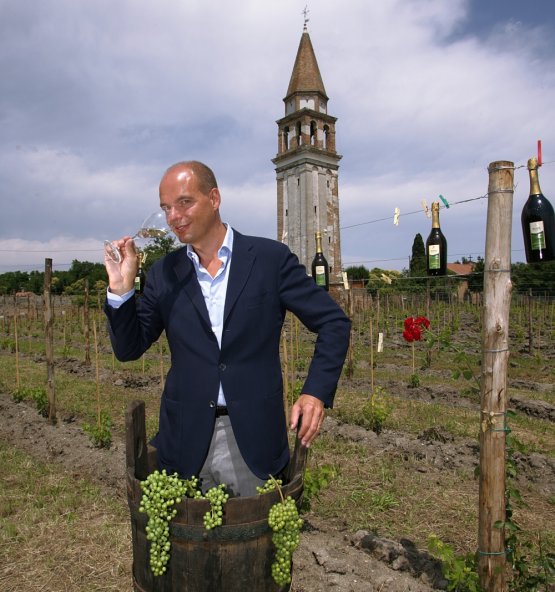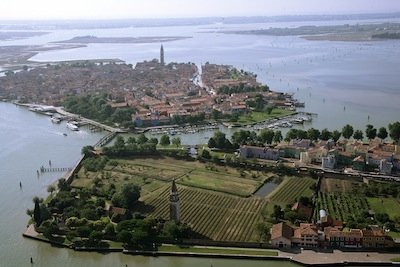No, there are no more vines growing in piazza San Marco. Not even on Canal Grande, nor in nearby Campo san Francesco della Vigna, around the homonymous church, whose name reveals very clearly the history of ancient harvests in the calli (the roads in Venice). The question is: what kind of grapes could grow here, between the vine leaves? Thick skin, rather shallow roots, since a little below there’s the lagoon; the grape variety needed to be resistant, it needed to fight against the tides, the salty water and the wind: just like Dorona, a white indigenous grape variety that was believed to be lost but whose plants were found among the lines of vines amateurishly grown by the Emmer, a historic family of antiquarians, in Torcello. Here wine was already produced in Roman times.

Gianluca Bisol, project curator
The recovery of the
Dorona grape, also known as “Uva d’Oro” (literally golden grape), is the pillar of the
Venissa project in Mazzorbo, that is to say the younger sister of Burano (they are connected thanks to a wooden bridge) a “farming” island par excellence, which for centuries had been used for the lagoon’s agricultural activities. This function, as “Venice’s vegetable garden”, returned to be a current matter when the
Bisol’s, a historic family of wine producers in Valdobbiadene, applied for the public funds necessary for the recovery of the
Scarpa-Volo estate, a testimony of the lagoon’s farming culture linked to the production of wine and vegetables as well as a perfect example of “walled vineyard” (the over 2 hectares are surrounded by an 18th century wall).
This was back in 2006, and a restaurant was created here, together with its vegetable garden (we wrote about it recently), a hostel and, as we mentioned, the vineyard. This is giving some satisfactory results: in these hours the harvest is taking place while since a few weeks ago it is possible to buy (on location or via their website) the 2011 vintage of Venissa, that is to say Venezia’s nectar, the second available after last autumn’s debut, with the 2010 vintage. The production is extremely limited (3.911 collectible bottles), produced only with Dorona grapes, at prices that are not very accessible and with some philological ambitions aimed at a very elegant niche wine that is a pure essence of Venice: instead of the label, there’s a precious gold leaf sculpted by the descendent of the ancient
Berta Battiloro family, and the bottle, designed by
Giovanni Moretti, is finished in the ovens of glassmaker
Carlo Moretti in Murano.

Venissa's vineyard. In the background, Burano island
And then there’s the Dorona grape, which bestows some surprising spicy notes in the glass, almost hinting at the commercial past of the Most Serene Republic, of its trades with the East... Liquorish, fruit, an obvious though subtle note of brine:
Desiderio Bisol, who took care of the oenological side of the project coordinated by his brother
Gianluca smiles: «The journey we have taken was not a banal one», it was necessary to overcome the obstacles given by temperature and salinity.
There were reassuring historical testimonies, «but we had to produce not just any wine, but a high quality one. For this reason I wanted to have a winemaker such as
Roberto Cipresso by my side. He’s an expert of terroir and is “specialised” in still red wines with a strong ageing potential. Being a white-wine-man myself, I tried to preserve the acidity and aromatic maturity characteristics. The result is given by these «bottles which represent the territory». Should you not be interested in purchasing a bottle, you can always taste this wine at
Venissa’s restaurant in Mazzorbo.